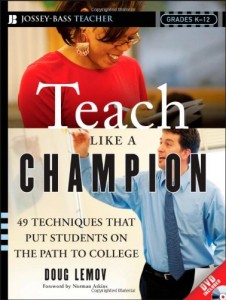49 Techniques That Put Students on the Path to College
 If you teach or train children or adults, you can find techniques in this book that are well worth everyone’s time.
If you teach or train children or adults, you can find techniques in this book that are well worth everyone’s time.
They come from David Lemov’s careful observation of the intersection of two things:
- Uncommonly high achievement data from unlikely schools
- Extraordinary teachers who get outstanding results despite the odds
What were these great teachers doing that worked? Mr. Lemov observed and videotaped his way to a list of 49 techniques that include the following categories: rigorous planning, setting expectations, and encouraging engagement.
Since then, he and others have trained hundreds of teachers to use these techniques, with great success. He wrote this book to make them easier to share, and thereby help even more students to succeed.
He describes each technique, illustrates it with examples, and explains what it will do for the teacher, student, and class. There is a disc included in the book with short videos illustrating many of the techniques. Here are brief descriptions of two of the techniques:
Stretch It: For this one, the teacher follows up to ensure that students can reliably answer similar or related questions. Let’s say a teacher asked the temperature for boiling water and a student answers 212 degrees. Additional questions could include:
- With what temperature scale?
- How many degrees is that in Celsius?
- What is the temperature for freezing water in Fahrenheit?
- How about freezing in Celsius?
- What if you are boiling water at an elevation of 5,000 feet?
- Let’s say you live in Denver, and you’re cooking dinner. How would that be different than cooking dinner in, say, San Francisco?
One of the great things about this technique is that you can directly involve more students, ensure they have a context for what they are learning, and include challenging questions that push them beyond simple, rote memorization.
Everybody Writes: Sometimes the first student with a hand up to answer a question doesn’t have the best answer—yet. When asking a question you want everyone in the room to think about, have the students quietly write the answer down, on paper. Once everyone has written their answer, then call on someone to share their answer with the rest of the class.
Using this technique ensures more engagement than letting a few students call out quick answers to every question. Because everyone must commit an answer to paper, this means that everyone has to actively think about the question. It also means that the quality of the answers may improve, because thinking about and writing down the answer provides a little time to think beyond the first obvious answer that comes to mind. This also prevents some students from sitting back and allowing others to answer every question. So with this technique, there’s no coasting.
I’ve used some of these techniques with adult audiences, and the training folks always ask me if I can provide more techniques like the ones I used. Reading this book is a great place to find them—and if you teach, train, or design training, you are likely enjoy the book, too.
Resources
Book: Teach Like a Champion: 49 Techniques That Put Students on the Path to College
Article: Building a Better Teacher
